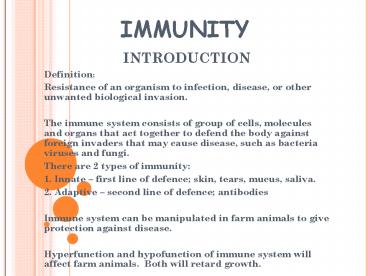IMMUNITY PowerPoint PPT Presentation
Title: IMMUNITY
1
IMMUNITY
- INTRODUCTION
- Definition
- Resistance of an organism to infection, disease,
or other unwanted biological invasion. - The immune system consists of group of cells,
molecules and organs that act together to defend
the body against foreign invaders that may cause
disease, such as bacteria viruses and fungi. - There are 2 types of immunity
- 1. Innate first line of defence skin, tears,
mucus, saliva. - 2. Adaptive second line of defence antibodies
- Immune system can be manipulated in farm animals
to give protection against disease. - Hyperfunction and hypofunction of immune system
will affect farm animals. Both will retard
growth.
2
- Hyperfunction
- Occurs as a result of over-functioning of the
immune system. For example, this manifests itself
as a number of allergic diseases. - Hypofunction
- Occurs as a result Increased incidence of
diseases and these diseases are more severe. - Development and maintenance
- Depends on thymus, lymph nodes, bone marrow and
spleen. It operates in 2 parts - 1. Antibody product
- 2. Cell mediated immunity
3
- Types of antibodies
- Antibodies or immunoglobulins are of several
types though they are made of similar units. The
antibodies are large proteins molecules specific
for particular antigens. - Anti bodies have 4 main types
- 1. IgM Most important( during early primary
response) - 2. IgG Most important during secondary
response. - 3. IgA Protects serromucous surface.
- 4. IgE Protects against parasite, important in
allergic reaction.
4
- Passive and active immunity
- Immunity can be active or passive.
- Passive is one that introduces antibodies
produced by another individual into the body of
animal concerned. For example during birth,
mother gives antibodies to new-born via colostrum
and milk. In cattle, sheep, goat, pigs and
horses, transfer is entirely from colostrum for
Day 1 and Day 2 after birth. Passive immunity
generally decreases in level along with time. - Active
- Immunity usually occurs through introduction of
vaccines in body developing resistance to a
certain disease. Usually this form of immunity
lasts for a long time.
5
- Effects of disease on growth
- Disease in many cases can retard growth. Effects
can be direct causing upset in metabolism and
absorption which can lead to diarrhoea. An
example of indirect response is animal consuming
less feed. - Some animal diseases can be transmitted to
humans, and control of these types of diseases,
known as Zoonoses, is vital to public health.
Some diseases are Salmonellosis, Feline
Leukemia, Ringworm and Coccidiosis. - If the animal has been exposed to sufficient
strong challenge, vector may not be able to
express itself. Therefore the growth rate is not
affected. - If vaccination has been done, it allows optimum
growth rate to manifest. Oral immunisation in
pigs and cows with enteropathogenic bacteria has
given these benefits.
6
conclusion
- The health of the body is dependent on the immune
systems ability to recognise and then repel or
destroy these invaders. - It is important to know about animal immune
system because when the animals suffer from
diseases, it affects their productivity and the
economic well-being of many industries. - In general, the functioning of the immune system
is still a mystery. With incoming technologies
and researches, we are looking forward to have
more information on the topic.

